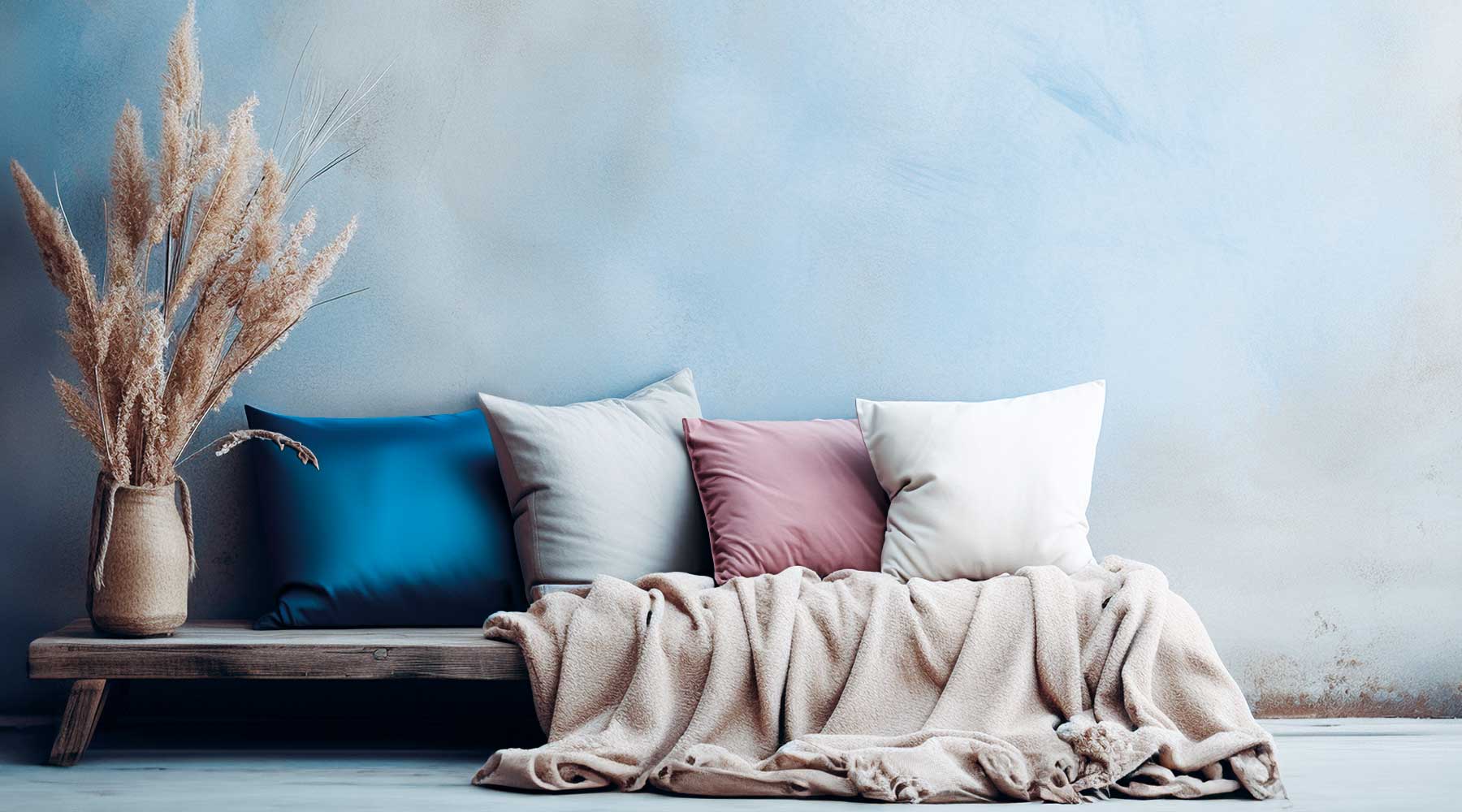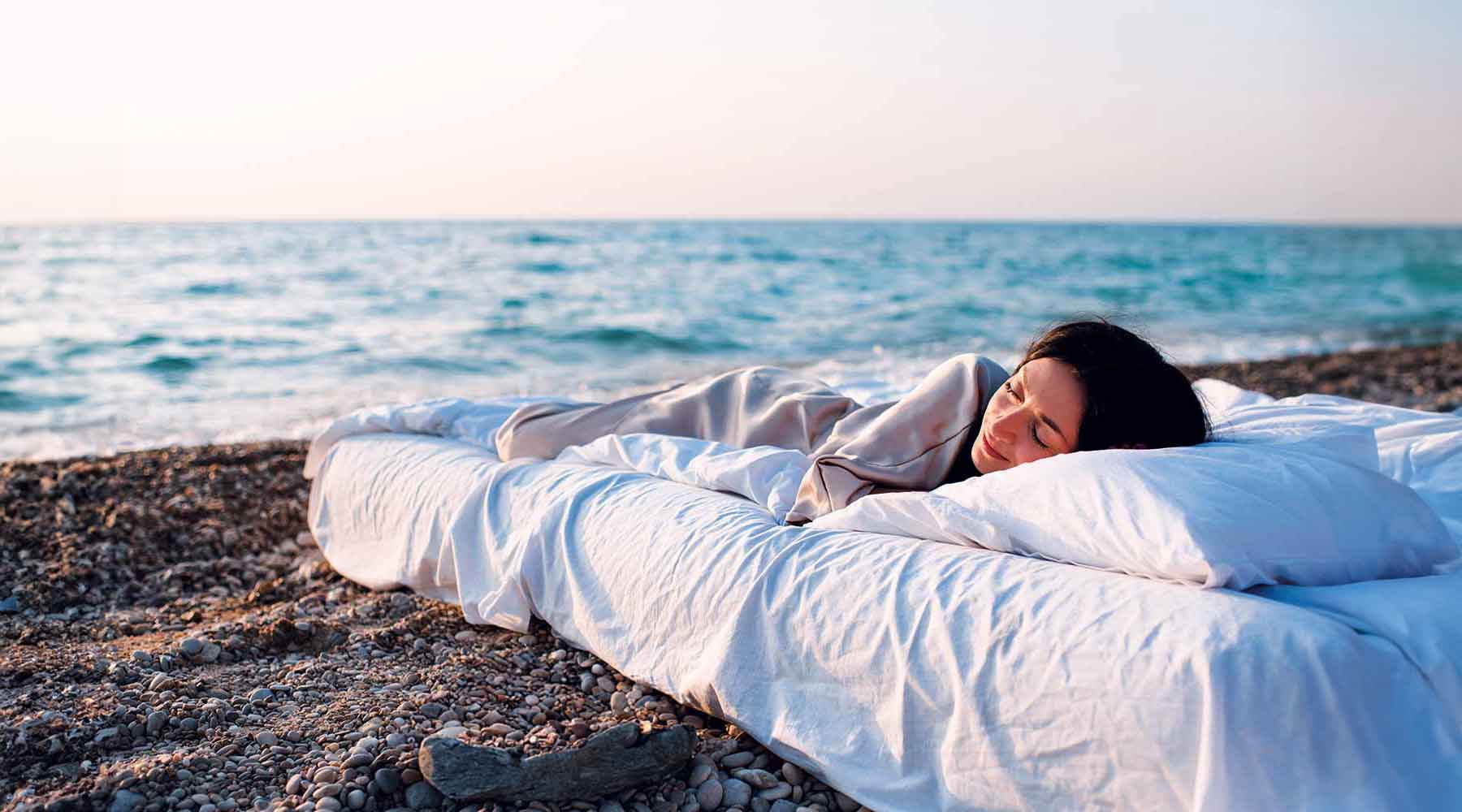
Which pillowcases are best?
Silk, cotton, or polyester—the fabric of your pillowcase can have various advantages and disadvantages for your skin, hair, and sleep quality. We explain which pillowcase is best suited for different sleeping needs.
Table of contents
- The right pillow
- Popular fabrics for pillowcases
- The best pillowcases for different needs
- Conclusion
1. Which pillowcase do I need?
Pajamas, blankets, pillows – cosy furnishings make bed truly comfortable. Often, we pay attention primarily to the filling of the bed linen and less on the cover we put them in. To complete a pleasant sleeping experience, the choice of cover can also be very important. Different selection criteria apply to the pillow than to the Duvet.
Depending on the sleeping position, the facial skin or the hair lies on the pillow and are pressed directly onto the fabric of the pillowcase. To maintain a fresh look throughout the day, you should choose a pillowcase that suits your needs and prevents excessive friction, pressure points, and dryness of the skin and hair. This applies not only to women, but also to men! ;)

An unsuitably chosen pillowcase can…
➨ lead to pressure points & promote the formation of wrinkles
➨ dry out the skin and cause skin irritations
➨ dry out the hair and lead to split ends and tangles
To prevent negative effects on skin and hair, the surface structure and moisture management of the chosen fabric are particularly important. We'll show you the advantages and disadvantages of different fabrics and which pillowcase is best suited to your sleeping needs!
Tip: The pillow itself should also be made of breathable material to promote an optimal sleeping environment. Click here for our Pillow Guide ➨.
2. Popular fabrics for pillowcases
Cotton
Cotton fabrics are highly versatile and can be processed in a variety of ways. They can absorb a lot of moisture and are generally easy to clean, creating a comfortable sleeping environment and reliably removing bacteria, mites, and sweat residue. Cotton jersey, flannel, or flannelette weaves have a skin-friendly, soft surface and keep you nice and warm. Seersucker, on the other hand, is less suitable as a pillowcase because its textured surface can cause pressure points and promote wrinkling.
silk
Silk is a natural fiber that is laboriously produced from the cocoon of the silkworm. It is both highly breathable and has a very smooth, flowing surface that feels soft and gentle on the skin. This creates a comfortable sleeping environment, with minimal friction and preventing dryness and irritation. skin and hair are prevented. However, the fine fabric is quite expensive and also delicate, as silk is not as easy to clean as other pillowcase materials.

bamboo
Bamboo pillowcases are becoming increasingly popular and are a sustainable, vegan alternative to expensive silk, which is also more durable and significantly more affordable. The organic bamboo fibers are naturally smooth and very soft, so they won't irritate the skin even when lying on them for extended periods. Bamboo pillowcases are also hypoallergenic, breathable, and moisture-absorbing.
Linen
Linen is made of breathable natural fibers that are relatively inelastic and retain their shape even after washing. The surface is generally quite smooth and soft, but not as supple as cotton or silk. Linen has a high Tear resistance makes the fabric very durable and hard-wearing. It also feels very light and airy on the pillow, which means the cover stays cool, especially in summer, rather than causing additional sweating.

Synthetic fabrics/polyester
Polyester is a synthetic material that offers an affordable and easy-care alternative to natural fibers. Contrary to popular belief, pillowcases made of polyester or microfiber can also boast a very soft, skin-friendly surface. They are very easy to care for, easy to clean, lint-free, and dry very quickly. The synthetic polyester fibers are also perfect for allergy sufferers because pollen, mites, dust, and bacteria cannot settle in the fabric.
3. The best pillowcases for different needs
For a beautiful, wrinkle-free complexion
To prevent wrinkles and lines from forming, avoid pressure points caused by fabric patterns and uneven surfaces. Look for a wrinkle-free pillowcase that stays put overnight and has a smooth surface. Breathable and easy-to-clean fabrics are ideal for keeping sweat, dirt particles, and bacteria at bay.
Recommendation: Silk and bamboo are kind to the skin and barely absorb moisture. Soft cotton fabrics can also help prevent wrinkles if your skin isn't as prone to dryness.

For beautiful hair
Frizz and split ends make hair look brittle and dull and are primarily caused by friction. This roughens the hair structure and can cause damage. A soft but smooth pillowcase and tying your hair back can help prevent knots and tangles.
Recommendation: Cotton satin or silk
You can find more tips for beauty sleep and a fresh look in the morning here.
For sensitive or dry skin
Avoid cotton, as it quickly draws moisture away from the skin and will dry it out even further. High-quality synthetic fabrics or natural fibers like bamboo or silk are antibacterial and ideal for use as pillowcases for sensitive skin.
Recommendation: Pillowcases made of high-quality synthetic or bamboo
For people who sweat a lot
At night we lose a lot of fluid through our skin and breathing, especially when it is under the covers or in the bedroom too warm Cotton, linen, and thicker synthetic fabrics can usually absorb a lot of moisture and simply release it back into the room without adding any extra warmth. This way, sweat and heat are drawn away from the body, maintaining a comfortable sleeping environment. If you do wake up drenched in sweat, you can simply remove the covers and wash them at high temperatures to completely eliminate germs and bacteria.
4. Conclusion
-
The most popular fabrics for pillowcases are cotton, silk, satin and polyester.
-
Silk and bamboo pillowcases are best for skin and hair.
Best wishes and see you soon!



Leave a comment
This site is protected by hCaptcha and the hCaptcha Privacy Policy and Terms of Service apply.